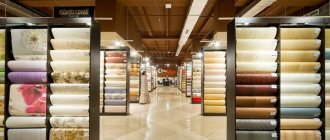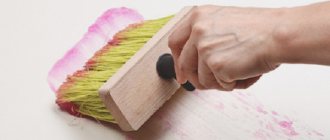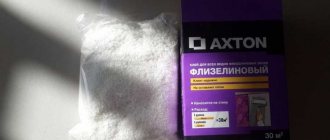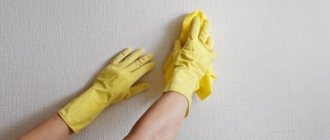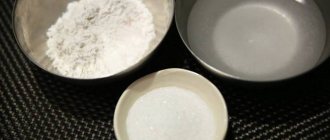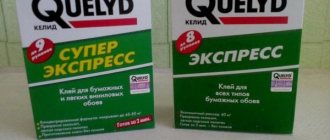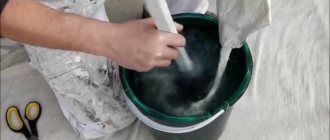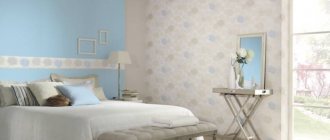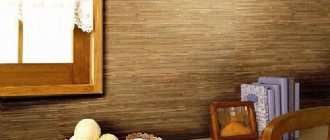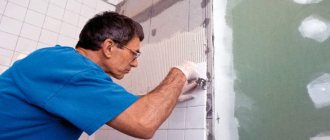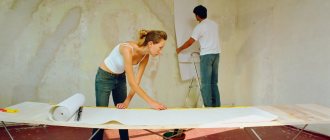Wallpaper glue requirements
Regardless of the composition and purpose, all adhesive mixtures must meet the following requirements:
- high adhesion – initial and final. The ability of the glue to hold still-dry wallpaper on the wall (with the possibility of correcting it), and after drying determines the strength of the connection between the finishing materials and the base;
- the consistency and viscosity of the composition allows it to be applied using a roller, brush or special devices in a layer 0.3-0.8 mm thick;
- curing speed , in the range of 10-30 min. This will allow for a thorough adjustment of the wallpaper panels;
- tensile strength after 24 hours is not less than 0.1 MPa, after three days (after complete drying) - not less than 0.3 MPa;
- low sensitivity to humidity . When washed or used in wet areas, the adhesion strength should not decrease by more than 20% of the indicators declared by the manufacturer;
- acidity _ It is advisable to purchase adhesive compositions with a neutral acid-base pH = 6...7. Their use reduces the risk of yellow spots appearing on light paper wallpaper.
The result of choosing the wrong brand of glue or violations in the technology of its use PHOTO: 124mastera.ru
Related article:
Wallpaper for walls: catalog of photos of interesting solutions for the living room, bedroom, children's room, kitchen and corridor. Read our review for basic rules for selecting canvases and designers’ recommendations.
Types of CMC glue
Conventionally, all types of adhesives are divided into those used for light, medium and heavy wallpaper. As for specific products, the following types of CMC can be found on sale:
- KMC-1 Chips. Used for gluing paper wallpaper, as well as light washable fabrics.
- KMC-1. Suitable only for paper wallpaper.
- KMC-N. Suitable for medium and light wallpaper on paper and textile bases.
- KMC-N SuperMax. Can be used for any wallpaper when gluing to concrete or plastered substrates.
- KMC-N MiniMax. Glue for washable wallpaper.
- KMC Extra Fast. Can be diluted for priming walls. Suitable for wallpapering concrete, plaster, dries quickly.
Some brands produce CMC with the addition of PVA. This product is suitable for covering walls with the strongest, heaviest canvases; it holds them securely without deformation. Important condition: wallpaper should be glued to any non-metallic base, as well as to unpainted surfaces. It does not adhere well to the latter and has a low degree of adhesion. Some adhesives additionally contain color indicators that allow you to assess which part of the canvas the product has already been applied to. After drying, these dyes lose color.
Composition of wallpaper glue and its classification according to purpose
Any wallpaper adhesive consists of three main components, the percentage of which varies depending on the purpose.
The basis is 50-100%. Typically, a dry material in the form of flakes or powder, which, after dilution with water, forms a viscous and sticky transparent mass. Most manufacturers use two types of materials as a base:
- Modified starch (MS) and its derivatives (carboxymethylcellulose “CMC”, carbomethyl starch “KMK”, hydroxypropyl starch “GPC”).
- Methylcellulose "MC".
PVA (Polyvinyl acetate) – its share accounts for 0-50%. An active additive that increases final adhesion.
Bioactive additives (bactericidal and fungicidal) – no more than 3%. Prevents the formation and spread of mold and mildew.
As a rule, manufacturing companies indicate the purpose of the adhesive composition directly on the packaging. Also in the names there are the designations “universal” and “special” indicating the type of wallpaper for which it is intended.
Despite the wide variety of brands, the composition of most brands of wallpaper glue is 90% the same PHOTO: remontami.ru
For light wallpaper (regular)
By light we mean paper wallpaper in one layer (simplex) and two layers (duplex). The second option is more resistant to external influences - humidity and ultraviolet radiation. The basis of the adhesive composition “KMC” and “MK”. Reinforcing additives (PVA) are practically not used. For paper wallpaper, universal adhesives with a less concentrated solution can also be used. The liquid consistency allows for better saturation of the finishing material, resulting in higher adhesion to the base.
For gluing one- and two-layer paper wallpapers, universal adhesives with a lower concentration are usually used PHOTO: images.ua.prom.st
Related article:
How to glue wallpaper correctly : choosing a tool and glue; sticking in difficult places: on corners, around windows and behind radiators; how to glue different types of fabrics: paper, non-woven, vinyl and self-adhesive; how to select a pattern and mask seams.
For heavy wallpaper (universal and special)
The composition includes PVA (up to 25%). Usually sold in the form of dry mixtures that require dilution with water. The concentration depends on the type of wallpaper and is indicated on the packaging. Used for gluing finishing materials of the following types:
- vinyl;
- textile;
- acrylic;
- structural (for painting);
- metallized.
For gluing expensive heavy wallpaper, it is better to use specially developed adhesive compositions PHOTO: mr-build.ru
Related article:
How to glue vinyl wallpaper on paper. The secrets of high-quality gluing of vinyl sheets on paper are in a separate publication on our portal.
Dispersed compositions
They have the highest adhesive properties. They contain 25-50% PVA and other additives. Used for gluing heavy and “special” trellises:
- with foamed, embossed and textile outer decorative layer;
- non-woven fabrics for painting;
- laminated (with a protective acrylic coating);
- on a fiberglass base.
Dispersion adhesive compositions are sold in the form of ready-to-use solutions PHOTO: rozetka.ua
Specialized
Bamboo, cork and some types of textile wallpaper require special adhesives. Neoprene and acrylate additives act as additional binders. Typically, such compositions have a viscous consistency and are applied using a spatula.
Adhesive for natural heavy finishing materials PHOTO: divotsvit.com.ua
Glue for non-woven wallpaper
This type of adhesive base has a number of advantages:
- Provides high-quality adhesion of wallpaper to the underlying surface.
- Absolutely safe for humans.
- Due to a special manufacturing technology (bactericidal preparations in the composition), it prevents the development of fungus and mold under the wallpaper.
- Has a sufficient shelf life in a diluted state.
The presence of excellent adhesive properties and bactericidal protection determine the popularity of this type of glue among buyers and interior decorators.
A significant disadvantage is the high cost of the adhesive, so a preliminary calculation of the amount of glue is simply necessary.
And detailed video instructions will allow the master to learn the main rules on how to glue non-woven wallpaper.
Release form
All existing types of wallpaper glue are available in two versions:
- Dry mixes. The main volume of the adhesive (base) is modified cellulose. Depending on its type, water of different temperatures is required to prepare the composition, which can be found on the packaging or on the manufacturer’s website.
- Ready-to-use formulations. Factory preparation method - control of external conditions and precise dosage make the adhesive mixture more effective. Such grades are used for fastening trellises that require special installation conditions.
Dry glue in the form of flakes PHOTO: irecommend.ru
Important! Glue for non-woven wallpaper, as a rule, is allocated to a separate category, since it is applied directly to the wall and must withstand a technological pause of about 10 minutes for deeper penetration into the base material.
Professional kit for wallpapering PHOTO: spkdon.ru
Related article:
How to put wallpaper on wallpaper. Option for gluing non-woven, liquid and vinyl coverings; what glue is best to use, how to prepare the surface, how to glue the canvas to the ceiling, methods for processing corners - read in our publication.
Wallpaper adhesive with fiberglass
Expensive, elite class wallpaper, the special structure of the fabric determines the need to use special mixtures for repairs.
This group of adhesive compositions has increased adhesive ability, dispersed base and resistance to moisture, temperature, and humidity.
Only environmentally friendly components are used in production, which do not contain allergens, but have antifungal properties.
Criteria for choosing wallpaper glue
When choosing an adhesive mixture for wallpaper, it is most advisable to be guided by the following initial data:
- weight and type of base finishing material;
- base material (usually walls);
- operational characteristics of the room: humidity, temperature, dynamics of change;
- additional parameters: the threat of mold and mildew, the need for systematic wet cleaning of walls, etc.
Manufacturability . Determines the ease of use of the adhesive mixture. An effective concentration should give the consistency of the working mixture, allowing you to easily apply the adhesive using a brush, roller or special apparatus to the surface of the wallpaper or wall. At the same time, the edges of the finishing materials should not curl, and the adhesive mixture should not appear on the front side. When working, any glue that has come out in the joints should be easily removed with a damp rag, without leaving any marks on the front surface, including after drying.
Mobility . A parameter that determines the ability of the adhesive to slide over the surface of the base. The high mobility of the newly applied adhesive mixture determines the possibility of a more accurate and thorough adjustment of the finishing material. This is especially important for photo wallpapers and wallpapers with complex compatible patterns.
Moisture resistance and adhesion recovery . Determines the ability of the adhesive to soften when exposed to excess moisture on the front part of the finishing material, and after drying to restore the strength of adhesion to the base.
The negative effect of moisture on wallpaper manifests itself primarily at the joints PHOTO: smartsoft.ru
Long term . The ability to hold the finishing material on the surface of the base in its original form, without the formation of swelling, wrinkles, cracking and divergence of joints.
Release of useful substances . Not critical, but an important parameter that determines the amount of costs for repair work.
Life period of the finished mixture . You should pay attention to this parameter if wallpapering is carried out on your own in several stages. As a rule, the prepared mixture can be stored in a tightly closed container for up to several weeks without losing its characteristics.
This is what ready-to-use adhesive for non-woven wallpaper looks like after mixing and a technological pause for maturation PHOTO: krrot.net
What characteristics should you pay attention to?
Turnkey renovation provides that all finishing materials will be selected and recommended by professionals. But some apartment owners prefer to decide for themselves what products to use. When choosing wallpaper glue, you need to focus on the following characteristics:
- wall surface;
- weight and material from which the wallpaper is made;
- operating conditions of finishing materials.
A good glue must meet the following requirements: reliability, durability, environmental safety, moisture resistance, economical use.
The presence of antibacterial substances or fungicides in the composition is considered an additional advantage.
Manufacturers divide mixtures into universal or reinforced. The first option is suitable for light weight paper wallpaper. Professionals recommend giving preference to specialized adhesives designed for a specific type of finishing material. Typically, manufacturers indicate the type of wallpaper on the packaging.
Calculation of glue requirements per 1 m²
It would seem that determining the consumption of wallpaper glue is quite simple. The required value is always indicated on the packaging. However, there are factors that can significantly increase or slightly decrease the amount of adhesive mixture used.
An example of a glue consumption table on packaging PHOTO: optolov.ru
The degree of readiness of the base surface . The wall must be treated with finishing putty, forming an even, smooth and dense layer. The putty must be coated with a deep penetration acrylic primer twice. This will reduce the absorbency of the material. Some manufacturers recommend using glue diluted in the appropriate proportion as a primer.
Important! If adhesive mixtures are applied to a base that has not been treated with a primer, they will not only be absorbed into it, which will cause overspending, but will also dry out quickly, which will significantly reduce the strength of the connection between the wallpaper and the wall.
Type of wallpaper and method of gluing it . The technology for gluing some types of wallpaper requires applying glue only to the panel (most paper), others only to the base (non-woven). There are types of wallpaper that require applying glue both to the panel and to the base (fiberglass and some vinyl). It is necessary to adjust the amount of glue purchased accordingly.
Table of consumption standards for some brands of glue, depending on the type of wallpaper PHOTO: domdvordorogi.ru
Determining the required volume of glue is quite simple. The area of the walls is calculated, and the space of window and door openings is subtracted from it. The resulting value is adjusted up or down depending on the previously mentioned factors.
Device for automatically applying glue to wallpaper PHOTO: bprice.ua
Types of adhesives
What glue should you use to glue paper wallpaper?
For each type of wallpaper, as usual, modern manufacturers produce different so-called adhesive compositions. It is very important to choose an adhesive specifically for your type of wallpaper. There is no need to glue paper wallpaper with glue from vinyl, etc. This does more harm than good. What glue criteria can be identified:
- Adhesive for light cardboard wallpaper . It must be emphasized that this is the most economical option, because its cost is the most affordable, but this does not mean that it is bad or of poor quality among more expensive analogues. This adhesive is intended for thin wallpaper. If you have this type of wallpaper (inexpensive, thin), feel free to buy this type of glue, focusing on the credibility of the manufacturer.
- Vinyl . Please note that this composition can be used to firmly stick wallpaper not only on a vinyl base. Using this glue you can also glue textile wallpaper. This glue has an interesting feature: after gluing the wallpaper, this glue does not immediately harden, which allows you to adjust the wallpaper sheet.
- Non-woven . Just imagine that this glue is designed specifically for all types, as we say - it is a universal material for gluing all types of cardboard (paper) wallpaper.
- There is also a special composition for heavy wallpaper based on fiberglass or velor, which provides increased strength and water resistance. This glue is rarely used, so we will not dwell on its description.
- It is not recommended to use all-purpose wallpaper adhesive, even if it is recommended to you by a sales consultant. It goes without saying that every reasonable person, even those far from construction, realizes that the same composition cannot be ideally suited for all types of wallpaper, and therefore it is risky to use it.
Vinyl glue
Wallpaper fixative containing the polyvinyl acetate mentioned above. This mass is used when working with heavy vinyl-type wallpaper. Only substances with good fixing properties can reliably glue the coating to the wall surface.
Attention! Lighter finishing options can also be done with a vinyl mixture, however, such use is uneconomical, since there are cheaper analogues for such tasks!
Non-woven glue
Material for gluing wallpaper with a base of cellulose fibers. The composition for non-woven wallpaper is also well suited for paper counterparts, but it cannot cope with vinyl coating.
Universal glue
This wallpaper adhesive for the wall is characterized by an affordable price and applicability to any standard types of wallpaper.
Advice! Despite this positioning of the product, universal glue should be treated with skepticism. It is impossible to glue, for example, heavy vinyl and paper (light) wallpaper equally well with one adhesive composition!
The type of glue under consideration will ideally cope with fixing paper finishing material, it will probably cope well with non-woven covering, but it will not work for gluing vinyl wallpaper. For them, it is always necessary to use special brands of glue that can provide reliable adhesion to the base.
Glue for glass wallpaper
A special dispersion composition with improved strength and excellent performance parameters. This wallpaper adhesive is quite expensive, but it can be successfully used in finishing wall surfaces with textile coverings.
Important! Wallpaper material “planted” on this type of glue can only be removed with the help of special solvent compounds!
Brand manufacturers
The modern building materials market offers a wide range of wallpaper glue brands. Some manufacturers position their products in the budget price segment as a universal composition suitable for gluing any type of wallpaper material. At the same time, they promise high adhesion rates under difficult operating conditions. However, experienced craftsmen strongly advise trusting only trusted manufacturers.
KLEO (France) . A brand under which universal and specialized adhesive mixtures are produced. Particularly popular is the Cleo Extra line of adhesives for heavy structured wallpaper. Available in the form of a dry construction mixture. It is quickly diluted with water and is ready for use in just a few minutes. Ready-made solutions are usually transparent and invisible on the surface. It also contains highly effective fungicides that reduce the risk of fungus. The finished mixture is suitable for use for 10 days.
Range of wallpaper adhesives under the KLEO brand PHOTO: stroy-podskazka.ru
Methylane (Germany) . Offers a full line of adhesive mixtures used for gluing all types of wallpaper. Provides particularly strong adhesion to mineral surfaces: plaster, concrete, brick. For several minutes, it allows the strips to glide, making it easier to place them on the surface.
Methylane is one of the largest manufacturers of wallpaper adhesives PHOTO: cyberportal.ru
Quelyd (France) . Designed for gluing heavy structured wallpaper, including non-woven wallpaper for painting. The maturation time of the mixed solution is at least 10 minutes. The mixture is applied to the working base (wall). The surface is suitable for painting after 24 hours. It has good adhesion, but at the same time, it can be easily removed from the base with a spatula.
Quelyd is one of the highest quality and most reliable adhesive compositions PHOTO: i.ytimg.com
Moment (Henkel Germany) . Highly adhesive composition based on methylcellulose. Preparation time is at least 15 minutes, the shelf life of the finished composition is up to 7 days. It also contains a variety of fungicides and antiseptics. Recommended for use in rooms with high traffic (hallway, living room) or high humidity (kitchens).
Moment - high-quality adhesive compositions produced by the international concern Henkel PHOTO: i.ytimg.com
PUFAS (Germany) . A universal adhesive that, depending on the concentration, can be used for gluing the entire range of wallpaper materials. Ready time when dissolved is no earlier than half an hour. Provides good adhesion to concrete, plaster and brick substrates, as well as wood and plasterboard.
PUFAS manufacturers pay special attention to the quality of their products PHOTO: alexgu.ru
How to prepare glue correctly - procedure
All manufacturers describe in detail the method of diluting the glue so that the user strictly follows the proportions of its dilution with water. The method for creating the adhesive mass is as follows:
- prepare dishes of sufficient volume (usually a plastic bucket with a lid is used),
- heat the water to +25 degrees (room temperature),
- pour water into a bucket, having previously measured it, then add glue in portions,
- Mix the composition thoroughly as it pours out,
- When adding all the adhesive powder, mix the product again,
- leave to infuse under the lid (for 2 hours).
Typically, when preparing a solution, manufacturers indicate the following proportions: for 500 g of glue - 8 liters of water. If the fabrics are dense, the amount of water is reduced to 7 liters.
Reviews on the use of various brands of glue
Feedback on the use of Adhesive Methylane "Flizelin Premium":
More details on Otzovik: https://otzovik.com/review_6439179.html
Adhesive Methylane "Flizelin Premium"
Feedback on the use of Henkel “Moment Indicator” wallpaper glue:
More details on Otzovik: https://otzovik.com/review_2032863.html
Henkel glue “Moment Indicator”
Feedback on the use of Quelyd “Super Express” wallpaper adhesive for paper and light vinyl wallpaper:
More details on Otzovik: https://otzovik.com/review_6504146.html
Wallpaper glue Quelyd “Superexpress”
Review of Quality “Master” non-woven wallpaper glue, professional:
More details on Otzovik: https://otzovik.com/review_5522832.html
Wallpaper adhesive Quality "Master" non-woven, professional
Review of Kleo Smart wallpaper adhesive for all types of vinyl wallpaper:
More details on Otzovik: https://otzovik.com/review_1977067.html
Wallpaper adhesive Kleo Smart for all types of vinyl wallpaper
Other applications of glue
In addition to being used as wallpaper, the composition can be used in other areas of industry. For example, it is indispensable when drilling wells in oil and gas fields in order to become a regulator of drilling fluids. It is also added to clay during the production of ceramic tableware to improve the quality of the material. Special processing of paper makes it more durable and creates an adhesive layer on the surface if necessary.
CMC is added to paints and varnishes as a thickener. It serves as the basis for water-dispersion paints and compositions intended for coating facades. Builders add CMC to putty and painting mixtures, again for improvement.
In addition to all of the above, CMC glue is actively used in the production of matches, faux fur, and detergents. It has also found its application in the mining industry and foundry production. In biological experiments, such a composition acts as an ion exchanger for sorbitol.
Price issue
The cost of glue will depend on its quality, type and manufacturer. Foreign-made wallpaper paste traditionally costs an order of magnitude more than domestically produced ones. We have selected the most popular and widespread wallpaper adhesives in our country and compared their costs:
- Universal adhesive of the Metylan brand, intended for all types of paper wallpaper, will cost an average of 105 rubles for a standard package weighing 250 grams.
- Methylane adhesive for vinyl wallpaper costs about 150 rubles for the same package.
- Methylane glue for non-woven wallpaper - from 180 rubles.
- Wallpaper glue "Methylane" pink, that is, with an application indicator, for vinyl wallpaper - 250 rubles for a 500-gram package.
- Kleo glue for non-woven, vinyl and textile wallpaper, 250 grams - about 100 rubles.
- The cheapest glue in a package weighing 100 grams that we were able to find is universal, Moment Classic brand for paper wallpaper - only 25 rubles.
- In addition, those who want to save money can purchase CMC wallpaper glue in bags at a price of about 68 rubles per kilogram, but it contains only methylcellulose, there are no antifungal additives, and is used exclusively for ordinary paper wallpaper.
- Omega brand adhesive for textile wallpaper - from 75 rubles for a standard package weighing 300 grams.
- Ready-made liquid wallpaper adhesives have a number of advantages - they definitely won’t contain lumps, are applied in a thinner layer, and are easy to use. Typically sold in 5, 10 and 15 liter buckets. The price of Bostik liquid glue for glass wallpaper averages 1,700 rubles per 15 liters.
- A 15-liter package of ready-made Kolorit brand adhesive for paper, textile and vinyl wallpaper will cost less - about 700 rubles.
- Another popular brand of wallpaper glue in our country is Quelyd. A package of such glue weighing 250 grams costs from 93 to 149 rubles, depending on the type.
Basic principle: the cheapest adhesives are for paper wallpaper, the most expensive are for fiberglass. Packages with greater weight are more economical. If you need to wallpaper a fairly large area, it is more profitable to buy a package weighing 500 grams than two - 250 grams each.
Some still believe that since the basis of wallpaper paste is starch, you can not buy ready-made mixtures at all, but make the paste yourself. For those budget-conscious homeowners, here is a simple recipe for homemade wallpaper glue.
For 10 liters of finished paste, you will need approximately 1 kilogram of ordinary rye or wheat flour or flour dust and any starch, for example, corn, potato or maize. Flour and starch previously sifted through a sieve should be diluted with water to the consistency of thick sour cream, stirring constantly - the danger of lumps appearing is very high. Then the paste is brewed, that is, brought to a boil. To increase the adhesive power, some recommend adding wood glue to the paste, but it can cause yellow spots to appear on the wallpaper. Therefore, it is better to use about 100 grams of regular PVA. To prevent the paste under the wallpaper from rotting, you can also add 50 grams of alum or 25 grams of 0.25% carbolic acid per 10 liters of paste.
Remember that it is difficult to guess the consistency and amount of PVA needed for reliable adhesion. The paste is stored for a very short time - it has the best adhesive properties immediately after brewing and cooling. Homemade wallpaper glue can come in handy if you haven’t calculated the amount of what you bought, but you want to re-glue the wallpaper right now. In other cases, frankly speaking, this is impractical - you will spend a lot of time, and taking into account the affordable cost of ready-made glue, you will not save that much.
